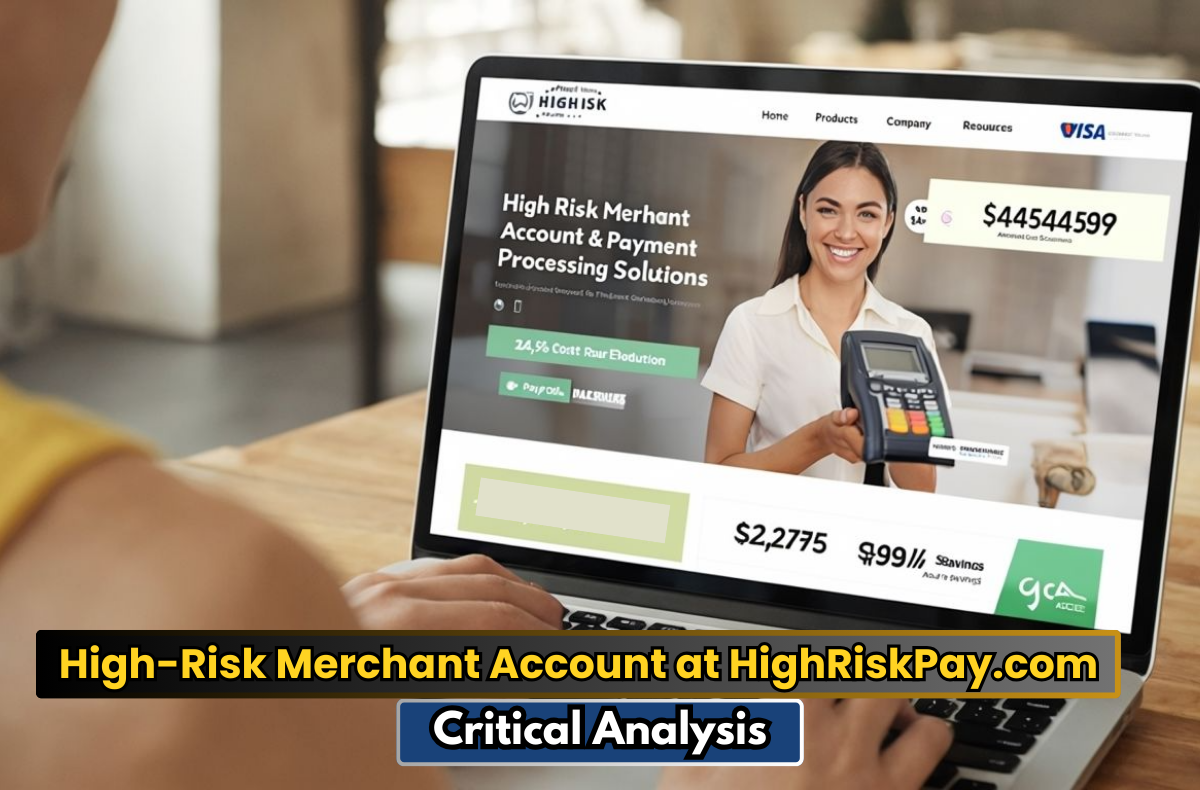Introduction
Running a business that gets labelled “high risk” by payment processors can feel like being shut out before you even apply. Many companies in industries like adult content, CBD, travel, subscription services, or those with past chargebacks or poor credit, struggle to find a merchant account that allows them to accept credit card or ACH payments. HighRiskPay is one of the providers catering to this segment. They claim to make the process simpler: submitting an application, signing agreements electronically, providing required documentation, and then getting set up. However, “simpler” doesn’t mean “easy” — because underwriting high-risk merchants involves extra scrutiny,
stricter policies, and more liabilities. This guide will walk you through what high risk means, what HighRiskPay offers, the documents you’ll need, typical fees and reserves, how you can improve your odds of approval, what to watch out for, and frequently asked questions. By the end, you’ll understand whether HighRiskPay is right for your business and how to prepare so you can get approved more smoothly.
What “High Risk” Means in Merchant Processing
-
Definition & Context
“High risk” refers to merchants who are more likely to generate chargebacks, fraud claims, or legal/regulatory risk, or who are in industries commonly tagged as high risk. Examples include adult content, CBD/hemp products, nutraceuticals, subscription-based services, travel, or remote/digital goods. Also, merchants with prior merchant account closures, high chargeback ratios, or poor credit may fall into this category. -
Implications for the Merchant
Being high risk usually means higher transaction fees, potential reserves (fix-or rolling), more documentation, stricter underwriting, regular monitoring, possible account holds, and sometimes abrupt terminations.
Understanding why you’re seen as high risk helps you address issues and present your business more favorably to providers.
Who HighRiskPay Is & What They Specialize In
-
HighRiskPay is a payment service provider that focuses on helping merchants whom mainstream processors reject, either because of the vertical (industry type) or prior risk exposure.
-
They support businesses with less-than-perfect credit, those with chargeback histories, and startups in high-risk niches.
-
Their process promises quicker onboarding, use of electronic signature tools, and integration support for payment gateway or ACH processing.
Step-by-Step: Applying at HighRiskPay — What to Expect
-
Initial Inquiry / Basic Application
You’ll provide basic info about your business: name, address, type of products/services, contact details, anticipated processing volume, average transaction size, and details about your industry. -
Full Merchant Application & Identity Verification
Be prepared to supply full legal information: business registration/incorporation documents, ownership structure, IDs for owners or principals. -
Document Submission
Commonly required documents include several months of recent bank statements, any previous processing statements if you had a merchant account before, proof of bank account ownership (voided check or bank letter), and marketing materials or website showing how you present your product/service to customers. -
Review of Business Model & Risk
Underwriters will assess your product/service, refund and cancellation policy, customer support, fraud prevention measures (such as AVS/CVV, fraud screening), and whether your site is compliant with norms (terms of service, privacy policy, etc.). They’ll also check your history: chargebacks, prior account closures, credit standing. -
Fee & Reserve Setup
Once approved, you’ll receive the merchant agreement. It will define fees (percentage per transaction, fixed fees, monthly fees), reserve requirements (rolling reserve or fixed reserve), chargeback thresholds, processing limits, and any other terms. -
Integration & Launch
After signing the agreement and satisfying the underwriting, you’ll get credentials (gateway/API, etc.), set up the payment processing in your systems, test it, and go live.
Documentation & Information Checklist
To improve the speed and chance of approval, have these ready:
-
Business formation/incorporation papers or equivalent among your legal region
-
Government-issued ID for all business owners or major stakeholders
-
Bank statements for the business account (usually last 2-3 months), and statements from any previous merchant accounts
-
Voided check or bank verification letter for settlement/bank account
-
Clear, professional website and product/service description; proof of refund/cancellation policy; customer terms and conditions and privacy policy
-
Any prior history: chargebacks, merchant account terminations, customer disputes, credit issues
-
Estimates or projections of processing volume, average transaction size
Fees, Reserves, and Costs: What to Expect in HighRiskPay
-
Transaction Rates
Likely higher than what low-risk accounts get. There will be a percentage charge per transaction and often fixed-dollar fees. -
Monthly / Maintenance Fees
Possibly a monthly fee for account maintenance, gateway usage, or reporting. -
Setup Fees
Some high risk providers charge setup or onboarding fees. HighRiskPay advertises minimal setup overhead in some cases, but depends on your industry and risk profile. -
Reserves or Holds
Expect either a rolling reserve (where a portion of your revenue is held back over time and released gradually) or a fixed reserve (a lump sum held for a period). The size and period depend on your risk, chargebacks, prior processing history, and sometimes predicted future volume. -
Chargeback Penalties
If chargebacks exceed a certain ratio or threshold, additional fees may kick in. Also risk of termination if too many disputes or fraudulent claims. -
Other Hidden Costs
Look for fees for gateway usage, refund processing, statement fees, PCI compliance costs, risk-monitoring fees, etc.
How to Improve Your Chances & Reduce Costs
-
Maintain Good Documentation
Clear, accessible policies (refunds, cancellations), privacy & terms pages, accurate product/service descriptions. -
Implement Fraud Prevention Tools
AVS (Address Verification System), CVV checking, fraud filtering, order verification processes. -
Monitor Chargebacks Closely
Have a system to respond quickly to disputes; try to resolve customer complaints before they escalate. -
Use Transparent Billing Descriptors
Make sure the name customers see on their statements is recognizable to avoid “friendly fraud” or confusion. -
Start with Lower Volume Projections if Uncertain
Overpromising can backfire; realistic estimates help underwriters trust your preparation. -
Maintain Clean Financial Records
Show stable bank statements, avoid bounced payments, show regular revenue if possible.
What to Watch Out For (Red Flags & Risks)
-
Vague or hidden fees in the agreement
-
Long reserve periods or excessive reserve amounts that tie up your cash flow
-
Poor customer support, especially when disputes or holds happen
-
Unclear terms for termination or sudden account suspension
-
Lack of transparency in how chargebacks are handled and how funds are released
Reputation & Trust: How to Verify HighRiskPay
-
Seek independent user reviews from merchants in your same industry
-
Look for any patterns: complaints about frozen funds, unexpected terminations, long holds
-
Ask for references — merchants that have used HighRiskPay successfully
-
Review their policies carefully; make sure industry best practices are enforced
-
Check their compliance with payment industry standards (PCI, etc.), how they handle fraud, and how transparent their fee schedules are
Read More: Professional Google Account Management in the Age of AI
Conclusion
Applying for a high-risk merchant account through HighRiskPay can open doors for businesses that mainstream processors reject. It’s not an easy path, but with preparation, clarity, and realistic expectations, you can succeed. Get your documentation in order, present your business honestly, use fraud prevention tools and transparent policies, monitor chargebacks, and always negotiate terms you can live with. Before you sign anything, ensure the fee schedule, reserve requirements, and termination policies are absolutely clear in writing. Evaluating HighRiskPay for trust and transparency is as important as getting the account itself.
If you proceed smartly, with full awareness of risks and costs, this approach can let your business process payments reliably and grow in a domain where many merchants are left out. If you want help drafting your application package or estimating what your fees and reserves might look like based on your specific niche or volume, I can help with that next.
FAQs
-
How do I apply for a high-risk merchant account at HighRiskPay?
You fill out their application form, provide business and personal identity information, submit documents like company registration, bank statements, and then, after review, complete and sign their merchant agreement before getting setup. -
What documents are required by HighRiskPay for approval?
Necessary items include business registration paperwork, IDs of owners, recent bank statements, prior processing history (if any), voided check or bank proof for payout account, and clear website and policy pages (refund, privacy, terms). -
How long does approval usually take with HighRiskPay?
It depends on how complete and clean your documentation is, whether there are any issues with your business vertical, and your chargeback history. Some merchants report fast approvals in a few days, others take a week or more. -
Will using HighRiskPay cost more than regular merchant accounts?
Yes, you should expect higher transaction fees, possible monthly or setup fees, reserve requirements, and charges tied to risk (e.g. for chargebacks). These are trade-offs in exchange for access to processing in higher-risk industries. -
What can I do to minimize risk and costs when applying?
Before applying, tighten up your fraud prevention, have strict refund/cancellation policies, ensure your website is professional and compliant, keep accurate and recent financials, and anticipate realistic volume and chargeback rates. Being transparent with the processor helps build trust and can improve terms.










